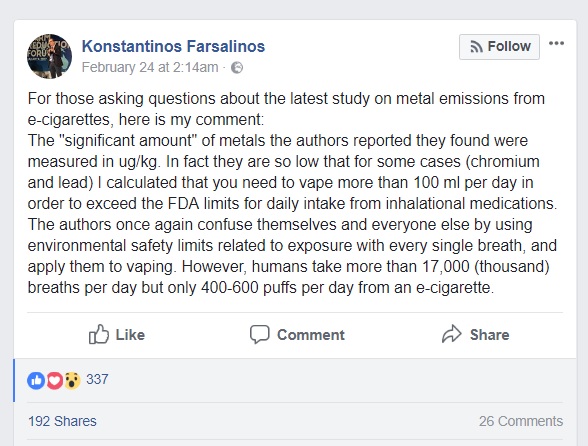Controversial Study Finds Toxic Metals in E-Cigarette Vapor, But Don’t Freak Out Just Yet
Researchers from Johns Hopkins Bloomberg School of Public Health, in Baltimore, Maryland recently published a study that suggests the coils in vaping devices may be leaking toxic metals like lead and nickel into the vapor when heated at high temperatures.
 After analyzing the e-liquid in the tank-style vaping devices of 56 daily e-cigarette users recruited through vaping conventions and flyers posted in e-cigarette shops, as well as the aerosol they produced, the team of researchers at Johns Hopkins Bloomberg School of Public Health identified the presence of several toxic metals, including toxic ones like lead, nickel, chromium and manganese, all of which can cause cancer, brain damage and harm the respiratory system, in high enough doses. Keep that last part in mind, because it’s important.
After analyzing the e-liquid in the tank-style vaping devices of 56 daily e-cigarette users recruited through vaping conventions and flyers posted in e-cigarette shops, as well as the aerosol they produced, the team of researchers at Johns Hopkins Bloomberg School of Public Health identified the presence of several toxic metals, including toxic ones like lead, nickel, chromium and manganese, all of which can cause cancer, brain damage and harm the respiratory system, in high enough doses. Keep that last part in mind, because it’s important.
Some of these contaminants were detected in the users’ e-liquid refills as well, although at levels not worth worrying about, but according to the study authors, the concentrations detected in the e-liquid close to the vaporizers’ heating element and the aerosol produced were a whole other matter. 48% of tested devices contained amounts of toxic metals that exceeded the limits deemed safe by the Environmental Protection Agency, and researchers point out that these were only the median levels, as some samples greatly exceeded those limits.
“These were median levels only,” senior study author Ana María Rule said. “The actual levels of these metals varied greatly from sample to sample, and often were much higher than safe limits.”
This suggests that while some vaping devices may be safe to use, at least as far as exposure to toxic metals, others could actually contain more than the levels presented in this study.
As for what’s actually caused the presence of lead and other metals in the tested vaping devices and the aerosol they produced, Rule and her team can’t yet say for sure, but they strongly believe it’s the metallic coils in the atomizers.
“We don’t know yet whether metals are chemically leaching from the coil or vaporising when it’s heated,” the researchers stated, adding that more research is needed to isolate the exact cause.
An interesting finding was that higher concentrations of toxic metals were found in atomizers that had had their heating coils recently replaced, which suggests that such leaks are more likely to occur from brand new heating coils than from newer ones. I knew my laziness to change coils more often would pay off someday…
Study co-author Angela Aherrera also tested urine and saliva samples from the 56 e-cigarette users who volunteered to participate in the study and found that they contained increased levels of nickel and chromium which were consistent with the concentration of these metals identified in the aerosol they inhaled.
Bad enough for you yet? Well, it gets worse. Analysis of the vaping devices provided by participants revealed the presence of arsenic in 10 out of the 56 samples, and the aerosol they produced. The source of this contaminant remains unknown and researchers do not specify whether the traces detected exceed safety limits.
Although they admit that the health impact of the detected metals is yet to be determined, Ruke and her team at the Johns Hopkins Bloomberg School of Public Health believe that it is important for the FDA to take into account their findings when drafting regulations. Hmm…
“It’s important for the FDA, the e-cigarette companies and vapers themselves to know that these heating coils, as currently made, seem to be leaking toxic metals – which then get into the aerosols that vapers inhale,” Ana María Rule said.
As is always the case with research that puts vaping in a bad light, this study has been picked up by virtually all the major news websites, and has been doing the rounds online for the past week. Most of the articles reporting on feature ominous titles and are meant to scare people into thinking that e-cigarettes are just as dangerous if not more so than tobacco cigarettes, even though this study didn’t even bother comparing the concentrations of toxic metals in e-cig vapor to those found in tobacco smoke.
But there’s one thing that none of these “informative” articles will tell you – that the study conducted by the Johns Hopkins Bloomberg School of Public Health is flawed. No one is disputing the fact that the detection of metals like lead in vaping devices is VERY disturbing, but going to great lengths to show that the traces levels discovered exceeded safety limits, by taking environmental safety limits related to exposure with every single breath and apply them to vaping is just plain wrong.
After seeing the results of this study being propagated in the media, Dr. Konstantinos Farsalinos, a Greek researcher who has been studying vaping for many years now, posted this message on his Facebook page:
For those asking questions about the latest study on metal emissions from e-cigarettes, here is my comment:
The “significant amount” of metals the authors reported they found were measured in ug/kg. In fact they are so low that for some cases (chromium and lead) I calculated that you need to vape more than 100 ml per day in order to exceed the FDA limits for daily intake from inhalational medications. The authors once again confuse themselves and everyone else by using environmental safety limits related to exposure with every single breath, and apply them to vaping. However, humans take more than 17,000 (thousand) breaths per day but only 400-600 puffs per day from an e-cigarette.
Dr. Farsalinos also announced that he is preparing a paper performing a “PROPER” risk assessment analysis of the findings presented in this study. We’re looking forward to hearing what he has to say about this.

















